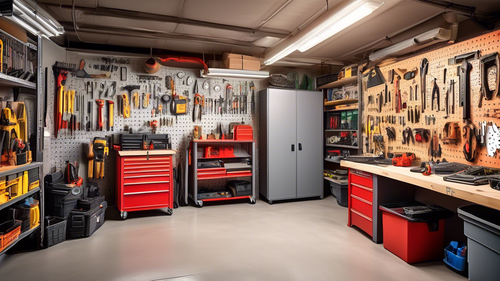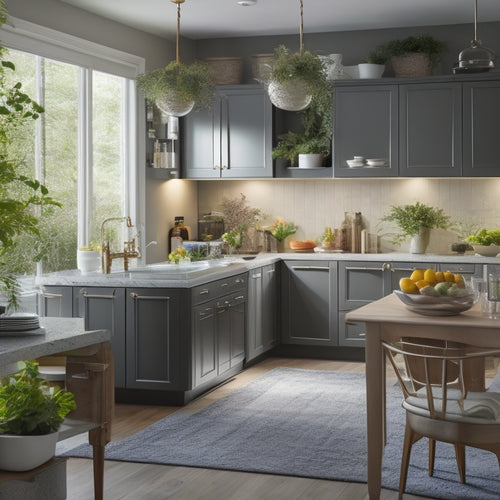
Transform Your Pantry With Simple Storage Solutions
Share
You can reveal the full potential of your pantry by incorporating simple yet effective storage solutions that maximize vertical space, exploit corners, and cleverly employ baskets, containers, and labels to create a organized and functional area that makes meal prep a breeze. Start by installing shelves or storage units that go up to the ceiling, and use adjustable shelving systems to customize the layout. Employ corner shelves, baskets, and containers to store items of varying sizes, and implement a labeling system for easy identification. As you optimize your pantry's real estate, you'll uncover even more opportunities to streamline your kitchen workflow.
Key Takeaways
- Maximize storage space with vertical shelving solutions, adjustable shelving systems, and corner shelves to optimize pantry real estate.
- Organize with baskets and containers of various sizes and styles to store items like produce, spices, and dry goods, adding warmth and visual appeal.
- Implement a labeling system with categories and color coding for easy access and identification of items in containers and on shelves.
- Repurpose everyday items like jars, tin canisters, and shoe boxes as creative storage solutions to enhance pantry organization.
- Design custom pantry organizer projects, such as DIY shelving and drawer dividers, to fit your specific needs and maximize available space.
Maximizing Vertical Storage Space
Every inch counts in a pantry, and maximizing vertical storage space is essential to making the most of this often cramped area.
You'll want to implement space-saving techniques to optimize your pantry's vertical real estate. Start by installing shelves or storage units that go all the way to the ceiling. This allows you to take advantage of vertical stacking, where you can store less frequently used items on higher shelves and more accessible items on lower ones.
By adopting a "one in, one out" policy Streamlining Personal Belongings, you'll maintain a clutter-free pantry and prevent new clutter from accumulating.
Consider using stackable bins, baskets, or containers to store dry goods, snacks, and other essentials.
Utilizing Corner Shelves Effectively
You've optimized your pantry's vertical space, now it's time to tackle those often-wasted corners. Corner shelves can be a transformative element in maximizing storage capacity. Consider the following styles and materials to suit your needs:
| Corner Shelf Style | Corner Shelf Material | Description |
|---|---|---|
| Fixed | Wood | Ideal for heavy items, provides sturdy support |
| Adjustable | Metal | Versatile and easy to install, perfect for varying item sizes |
| Rotating | Glass | Offers easy access and visibility, great for spices or oils |
When choosing a corner shelf, think about the items you'll be storing and the space constraints. Measure your corners carefully to guarantee a seamless fit. With the right corner shelf, you'll be able to make the most of this often-underutilized area.
Baskets and Containers Galore
Optimizing your pantry's storage capacity involves more than just shelves; it's also about cleverly utilizing baskets and containers to keep items organized and easily accessible.
By doing so, you'll create a system that's both functional and visually appealing.
-
Woven baskets filled with fresh produce or bread add a touch of warmth to your pantry
-
Decorative containers holding pasta, rice, or coffee beans create a sense of elegance
-
Stackable bins for snacks or spices keep countertops clear and clutter-free
- Clear plastic containers for dry goods allow you to see what's inside without labels
Labeling and Categorizing Essentials
You'll find that assigning categories for easy access is vital to a well-organized pantry, as it allows you to store similar items together.
By using labels for quick identification, you can instantly see what's inside each container or shelf, saving you time and frustration.
With an organized shelf structure, you can maximize your pantry's storage capacity and guarantee everything has a designated place.
Categories for Easy Access
Organization is the backbone of a functional pantry, and categorizing essentials is an essential step in achieving this goal. By grouping similar items together, you'll create a sense of order and make meal prep a breeze.
Consider categorizing your pantry into sections such as:
- Cooking essentials: oils, spices, and cooking tools
- Snack storage: kid-friendly options and healthy snacks
- Bulk items: grains, canned goods, and seasonal ingredients
- Dietary preferences: gluten-free, vegan, or other special diets
This system allows you to see what you have, what you need, and what you can get rid of, making it easier to maintain your pantry inventory and stick to your kitchen themes.
Labels for Quick Identification
These labels become your pantry's roadmap, guiding you to the exact item you need in a split second.
You'll find various label types, from decorative labels with a vintage flair to waterproof labels for humid environments. Invest in a label maker to create custom labels that fit your style.
For quick tips, use color coding to categorize similar items, and place labels at eye level for easy reading. When it comes to label design, opt for minimalist labeling to avoid visual clutter.
Strategically place labels on bins, baskets, and shelves to create a cohesive look. Remember, label placement is key – keep them consistent and visible to guarantee you can find what you need in an instant.
Organized Shelf Structure
Beyond the labels, a well-structured shelf is critical to maintaining a clutter-free pantry. You need to optimize your shelf's layout to guarantee everything has its designated spot.
Consider the shelf height and shelf depth when deciding how to allocate space.
-
Reserve top shelves for infrequently used items, like special occasion dishes or seasonal decorations.
-
Designate middle shelves for everyday essentials, such as canned goods and snacks.
-
Use bottom shelves for heavy or bulky items, like pots and pans or cooking utensils.
- Leave some breathing room between categories to prevent clutter from building up again.
Adjustable Shelving Systems Work
With adjustable shelving systems, you can maximize your pantry's storage capacity by customizing the shelves to fit your specific needs.
Adjustable heights allow you to accommodate items of varying sizes, while modular design enables you to create customizable layouts that optimize space efficiency.
Load capacity is also a key consideration, ensuring that your shelves can support the weight of your pantry staples.
Easy installation means you can get started right away, and the aesthetic appeal of these systems adds a touch of sophistication to your pantry.
Made from durable materials, adjustable shelving systems are built to last, providing a reliable storage solution for years to come.
Repurposing Everyday Items
You've likely got a stash of everyday items sitting around your home, collecting dust and serving no particular purpose.
But what if you could give them new life as pantry storage solutions?
Think about it: those *
- repurposed jars can store spices or coffee beans
- tin canisters can hold snacks or baking supplies
- shoe boxes can organize packets of pasta or rice
- wine crates can become a rustic storage unit for canned goods
DIY Pantry Organizer Projects
You're ready to take your pantry organization to the next level with some DIY projects.
You'll start by designing custom pantry shelving ideas that maximize your space.
Then move on to creating pantry drawer dividers to keep items separate and easy to find.
Pantry Shelving Ideas
Optimizing your pantry's storage capacity begins with a well-designed shelving system. You want to create a space that's functional, yet visually appealing.
Consider the shelf height, ensuring it's accessible and easy to maneuver.
- Install adjustable shelves to accommodate items of varying sizes
- Incorporate decorative elements, such as crown molding or trim, to add a touch of elegance
- Use baskets or bins to store dry goods, keeping them hidden from view
- Add a pegboard for hanging items like spices, oils, or utensils, keeping them organized and within reach
Pantry Drawer Dividers
Three-quarters of pantry disorganization stems from cluttered drawers. To tackle this issue, create custom pantry drawer dividers that fit your specific drawer dimensions.
Start by measuring the width, height, and depth of your drawers. Choose divider materials that are sturdy and easy to clean, such as wood, plastic, or metal. You can use dividers with adjustable sections to accommodate different-sized items.
Label each section to maintain organization and make it easy to find what you need. Consider using dividers with built-in utensil holders or spice racks to maximize storage space.
Pantry Basket Systems
A sturdy shelf lined with baskets can be a game-changing element for pantry organization. By incorporating a pantry basket system, you'll be able to create a visually appealing and functional pantry layout. This system allows you to categorize and store items in a way that makes sense for your needs.
-
Wicker baskets filled with fresh produce, such as apples and oranges, add a touch of warmth to your pantry.
-
Clear plastic bins labeled with contents, like "Baking Supplies" or "Snacks", provide easy identification and access.
-
Small baskets corral small items, like spices or oils, keeping them from getting lost.
- Larger baskets store bulk items, like pasta or rice, keeping them organized and out of the way.
With a pantry basket system, you can achieve seasonal organization and maintain a sense of control over your pantry's contents.
Frequently Asked Questions
How Do I Prevent Moisture Buildup in My Pantry Storage Containers?
As you confront the damp, musty aroma wafting from your pantry, you're determined to banish it; to do so, you'll conquer moisture control by opting for airtight containers, ensuring a dry, fresh environment that preserves your stored goods.
Can I Use Adjustable Shelving Systems With Uneven Pantry Walls?
You can effectively install adjustable shelving systems on uneven pantry walls by measuring carefully, using wall anchors, and adjusting shelves to fit your specific needs, ensuring a sturdy and customized storage solution.
Are There Any Eco-Friendly Pantry Storage Options Available?
You're looking for eco-friendly pantry storage options; you'll find sustainable materials like bamboo, recycled wood, and repurposed containers that reduce waste. Opt for zero waste containers made from glass, stainless steel, or BPA-free plastic to minimize your environmental footprint.
How Often Should I Clean and Reorganize My Pantry Storage Systems?
As you savor the sweet taste of organization, remember to dust off your pantry's hidden corners regularly; aim to tidy up every 2-3 months, and perform a deeper clean quarterly, using these pantry organization tips to maintain a cleaning schedule that's as effortless as a Sunday brunch.
Can I Install Pantry Storage Solutions Myself or Do I Need a Professional?
You can attempt a DIY installation, but consider your skill level and time constraints; if you're uncertain, it's best to seek professional help to guarantee a perfect fit and ideal functionality for your pantry storage solutions.
Related Posts
-

Garage Organization 101
Garage Organization 101: The Ultimate Guide to a Tidy and Efficient Workspace Are you tired of stepping into your ...
-

Streamline Your Small Bathroom With These Systems
You can reveal your small bathroom's hidden potential by implementing a few strategic systems that maximize every inc...
-

Why Corner Cabinets Are a Kitchen Essential
You're sitting on a goldmine of untapped storage potential in your kitchen - the often-wasted corner spaces that can ...


